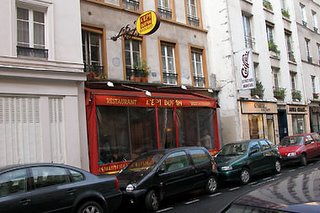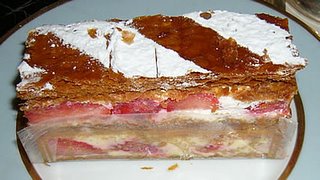


Last night, I sat in on a popular French radio program called Le Téléphone Sonne (“the telephone is ringing”) on national frequency France Inter. The topic at hand was “Où commence l’Anti-Sémitisme?” (“Where does anti-Semitism begin?”), a response to the recent death of 23-year old French Jew Ilan Halimi, left for dead, bound and naked, beside railroad tracks near Paris on Feb. 13 by a multiethnic gang known as the Barbarians. Show host Alain Bédouet was joined by Nicolas Weil, an editor of Le Monde and author of myriad articles and books on anti-Semitisme, André Kaspi, a historian (who I, in fact, quoted in my senior year honors thesis) and another quasi-historian whose name I couldn’t seem to catch. The show consisted of a round-table discussion with intermittent phone calls from listeners. To prepare, Bédouet read some of the emails he’d received from listeners, and went over some of the issues he wanted the participants to address. While waiting for the red light to flash signaling the start of the program, the participants were laughing amongst themselves and talking about the bird flu (a topic on everyone’s mind here in France these days). Bédouet was horrified that his cat had brought home a dead bird the day before.
The program opened with a question from a listener who asked what distinguishes racism from anti-Semitism. Are Jews different from other victims of Racism? he wondered. Weil responded that “parfois l’un et l’autre se croisent” (“sometimes the two overlap”) but added that anti-Semitism and Racism don’t have the same history and are thus not identical. Caroll added that “we should be shocked by all forms of discrimination, no matter who the target is.” He went on to give statistics proving that, in fact, Arabs and Muslims are actually more discriminated against in France than the Jews. Kaspi cited the etymologic origins of anti-Semitism and, like Weil, emphasized the unique history of anti-Semitism, and its specificity as a form of racism directed at the Jewish people. “Anti-Semitisme designates a particular hostility towards the Jews,” he explained. “Racism is a more general concept, anti-Semitism has its own history and specificity,” he argued, making a reference to the Protocols of Zion.
Later, Nicolas Weil brought up the subject of the “surmédiatisation” of the Israeli-Palestianian conflict in the press, in other words this idea that the press tends to exacerbate certain situations by exaggerating their grandeur. Kaspi then went on to distinguish between anti-Judaism and anti-Semitism, again citing anti-Semitism’s etymological origins and stressing the fact that anti-Judaicism has existed since the origins of Christianity and is based on more religious prejudices. According to Kaspi, “anti-Semitism begins when prejudices from former centuries resurface.” He also added that modern anti-Semitism is based less on religious than on social issues, pointing out that “Jews represent an integration into French culture that is quite remarkable considering French history.”
Kaspi also talked about ignorance as an excuse for anti-Semitism, and argued that, while those living in France from 1940-1944 could claim a certain degree of ignorance about the activity of the Vichy government, in this day and age, “quand on veut savoir, on peut savoir.” (“when we want to know, we can know.”) In his opinion, historians do their job better today than in the past.
Nicolas Weil then addressed the importance of word choice when discussing anti-Semitism. In his opinion, “Malnommer les choses, c’est là où commence les malheurs du monde.” (“misnaming things, that’s where all of the misfortunes of the world begin.”) All of the participants agreed that a great deal of effort must be made on the part of French society, especially in educational establishments, to designate appropriate wording to different situations.
Kaspi continued: “Jewish identity is not just a religion, it’s a collective history. One can be Jewish and not religious. Modern prejudices are directed towards anyone Jewish – “the Jews killed Christ”, “Jews have all the money and the power”, etc. – even those that are not even tied to the religion, which makes things complicated.” Weil concluded by adding that anti-Semitism isn’t just limited to certain parts of the city or the world, that it is found everywhere.
The question of anti-Semitism is an interesting one, from my perspective as a Jewish American living in France. Whenever I tell people that I live in Paris, they all warn me that the French are all anti-American and anti-Semitic. While it is true, based on national statistics, that anti-American and anti-Semitic sentiment does exist in France, I personally haven't encountered any myself, but then again I don't, as many of my friends have pointed out, wear a big Jewish star around my neck and a tallis around my neck and chant Hebrew hymns through the streets of Paris. Halimi's death is unfortunate and unnerving - he is 23 years old, the same age as me, and did nothing to provoke such malicious violence. Who is to say that something similar won't happen to me or one of my peers? What is even more disgusting is the following excerpt from yesterday's New York Times: "Dressed in a sweat suit, with a female companion at his side, Mr. Fofana, 25, dined on a meal spread out on a wooden chair, smiling frequently for a television camera and calmly responding to questions about the grisly killing of the salesman, 23-year-old Ilan Halimi." The French response has been at least somewhat reassuring. Last week, Chirac and other government officials attended Halimi's memorial service, and last Sunday, tens of thousands of people invaded the streets of Paris to protest the killings and the rise of anti-Semitism in France. The idea that the killers targeted Halimi because, in the words of political scientist Jean-Yves Camus, "According to them, all Jews are merchants and all Jewish merchants are rich," is frightening indeed.

After the program ended, I had dinner at l’Epi Dupin, my new favorite neighborhood bistro, right by Bon Marché. The three-course 31-Euro menu is forced upon you, but it’s well worth it. The place is always packed – we reserved ahead of time and, despite the fact that it was a snowy Tuesday night in the middle of February, there wasn’t even enough room for us to wait inside for our table. Despite the noisy crowd and extreme lack of elbow room, I must note that l’Epi Dupin is NON-SMOKING (a concept that hasn’t quite reached ubiquity here in this city of lighting up) which did make for a wonderful evening of fresh air dining. I started with a green salad, then followed with sauteed scallops on a bed of “fondu de blettes”, I still haven’t figured out what the English equivalent of a blette is, it’s some kind of leek-like vegetable, but it didn’t matter because the blettes were overpowered by a rich, creamy, flavorful fondue. I wiped my plate clean with some fresh bread – crispy on the outside, fluffy on the inside, as all bread should be. For dessert, I had a “feuillantine de pommes” which was a combination of my two favorite French desserts of all time: the tarte tatin and the millefeuille. Crispy layers of French pastry were filled with warm, caramelized apples, and the dish was complemented with a scoop of vanilla ice cream and caramel oozing over the plate. It was nothing short of a saccharine orgasm.
Word of the day: Tarantism
tar·an·tism (trn-tzm)
n.
A disorder characterized by an uncontrollable urge to dance, especially prevalent in southern Italy from the 15th to the 17th century and popularly attributed to the bite of a tarantula.
[New Latin tarantismus, after Taranto.]
Quote of the Day: "I must confess, I was born at a very early age." - Groucho Marx


Pastry of the Day: The Millefeuille
You may know it as a Napoleon. The Millefeuille, one of my favorite French pastries - after the Tarte Tatin bien sur - consists of layers of puff pastry interspersed with pastry cream. There are many different varieties of the millefeuille. Some choose to ruin a perfectly good dessert by filling the pastry layers with chocolate cream, while others are more creative and add fresh fruits to the vanilla cream filling or top with confectioner's sugar or caramel.
It is believed to have been developed in France during the latter part of the 19th century. The Danish people have been told for generations that a Danish royal pastry chef invented the dessert way back in the 1800s on the occasion of a state visit between the Emperor Napoleon and the King of Denmark, in Copenhagen. Some sources believe that the chocolate lines on the pastry appear to form the letter "N" for Napoleon. Another myth claim that the dessert was really a French invention after all, and that it was Napoleon's favorite pastry. It is said that he ate so many of them on the eve of Waterloo that he lost the battle. So THAT's the true meaning of a "Napoleon complex" ...


1 comment:
Very interesting blog! It'a amazing what you have been experiencing. Did you speak on the radio show? We are very proud of you! e & s
Post a Comment